My apologies to all of you who read my essays. Two days ago, the server for all of our associated websites and this blog crashed. All is rebuilt now, but my latest post, this post named “Sustaining” was a casualty, but for the beginning two paragraphs. The original version cannot be restored. To follow is a rewriting of that post. For those of you that were able to read before the crash, I hope this version will be tolerable, or better. For those of you seeing it for the first time, this is the first in a series I hope to write about planting containers for the garden. It’s that time.
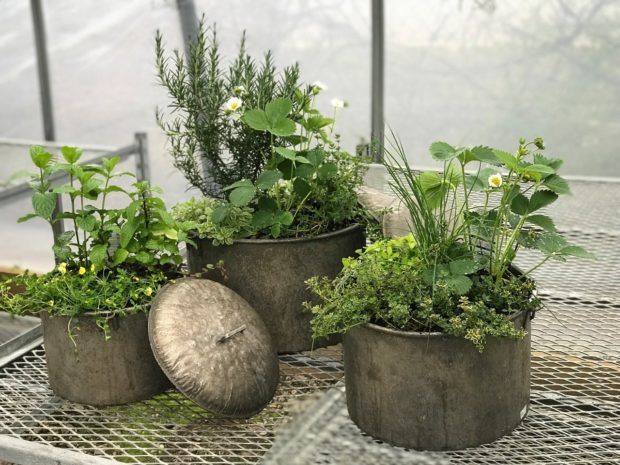 The instinct to sustain comes standard issue with all living things. Animals strengthen and support their newborn young with mother’s milk, a home, and protection from danger of all sorts. That Mom supplies her young with all of the necessities of life, whether it comes from her, or from a source of water, shelter or food nearby. Some parents with no innate directive to protect or feed their young produce progeny by the hundreds or thousands. Sustenance comes in a lot of different forms. People, those most complex of all the creatures, do much the same, but in a more complex and individual way. Luckily, many kids lacking sustenance emerge with a will to grow, standard issue. Some seed within them grows. What is truly amazing is how many varied paths of affirmation work. Astonishing, this. Plants likewise have mechanisms to not only grow, but protect their own survival for generations to come. Even the most cursory study of seeds, and the conditions under which they germinate and grow, makes it clear that the urge to survive is a most basic tenet of life. The flowers have a grand purpose. Pollination and the the eventual production of seed insures the survival of the species. Those of us who treasure flowers whenever they appear are witnessing the story of how a species is sustained from one generation to the next – every bit as much as their ephemeral beauty.
The instinct to sustain comes standard issue with all living things. Animals strengthen and support their newborn young with mother’s milk, a home, and protection from danger of all sorts. That Mom supplies her young with all of the necessities of life, whether it comes from her, or from a source of water, shelter or food nearby. Some parents with no innate directive to protect or feed their young produce progeny by the hundreds or thousands. Sustenance comes in a lot of different forms. People, those most complex of all the creatures, do much the same, but in a more complex and individual way. Luckily, many kids lacking sustenance emerge with a will to grow, standard issue. Some seed within them grows. What is truly amazing is how many varied paths of affirmation work. Astonishing, this. Plants likewise have mechanisms to not only grow, but protect their own survival for generations to come. Even the most cursory study of seeds, and the conditions under which they germinate and grow, makes it clear that the urge to survive is a most basic tenet of life. The flowers have a grand purpose. Pollination and the the eventual production of seed insures the survival of the species. Those of us who treasure flowers whenever they appear are witnessing the story of how a species is sustained from one generation to the next – every bit as much as their ephemeral beauty.
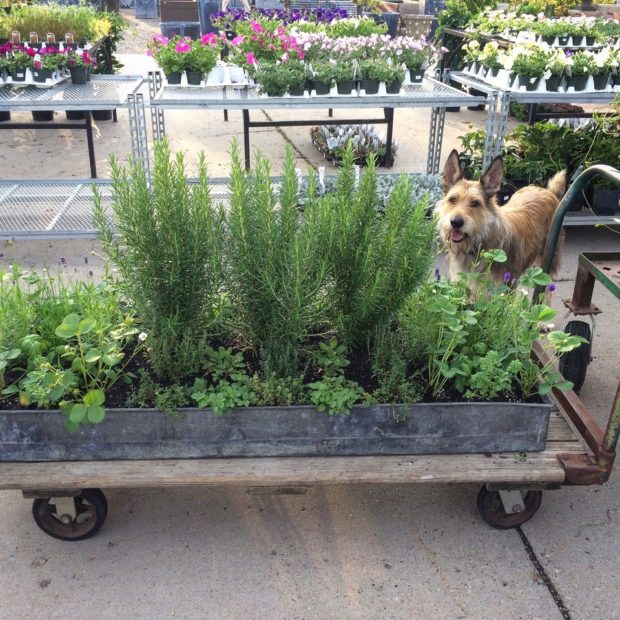 Anyone who gardens has that instinct to nourish and nurture. That comes part and parcel with the urge to try to make something grow. The effort it takes to grow and sustain a landscape and garden is considerable. Aching backs, permanently dirty nails and sunburned noses, scrapes scratches, bruises, frustrations and failures tell the story. All that effort in search of that perfect moment. The gardener enjoying the garden they create and sustain. The natural world is a world in which every living thing jostles for space, breathes, and prospers, or not. The outcomes are not always predictable or positive. Every living thing is as capable of sustaining injury or damage as they Anyone who gardens has seen treasured plants demolished by deer, or destroyed by an exceptionally hostile winter. The list of the plants that have died on my watch is a very long list. Those plants that have persisted are a source of great joy. Life and death in the garden is pure theater. Why else would gardeners come back for more, year after year? The spring season is anticipated for months, and the experience of watching plants break dormancy and grow is an experience like no other.
Anyone who gardens has that instinct to nourish and nurture. That comes part and parcel with the urge to try to make something grow. The effort it takes to grow and sustain a landscape and garden is considerable. Aching backs, permanently dirty nails and sunburned noses, scrapes scratches, bruises, frustrations and failures tell the story. All that effort in search of that perfect moment. The gardener enjoying the garden they create and sustain. The natural world is a world in which every living thing jostles for space, breathes, and prospers, or not. The outcomes are not always predictable or positive. Every living thing is as capable of sustaining injury or damage as they Anyone who gardens has seen treasured plants demolished by deer, or destroyed by an exceptionally hostile winter. The list of the plants that have died on my watch is a very long list. Those plants that have persisted are a source of great joy. Life and death in the garden is pure theater. Why else would gardeners come back for more, year after year? The spring season is anticipated for months, and the experience of watching plants break dormancy and grow is an experience like no other.
 Gardeners of all description are in the full swing of it now. All because the relationship people forge with nature is sustaining. There are landscapes and gardens being cleaned up. There are new plants going in the ground. There are plans for a new terrace, or a fountain. Some older landscapes are getting a refresh. A garden bench is getting a fresh coat of paint. I for one have always enjoyed weeding; its solitary and contemplative byproduct is a tonic. Pulling weeds does not require much in the way of concentration, so there is time to hear the birds. In a frantic world, the garden is other worldly, and restorative. That spring move into the garden is the emotional equivalent of a trip to the cottage or the beach without any travel time involved. We mark the beginning of the summer gardening season by planting containers. It’s a specialty of the house.
Gardeners of all description are in the full swing of it now. All because the relationship people forge with nature is sustaining. There are landscapes and gardens being cleaned up. There are new plants going in the ground. There are plans for a new terrace, or a fountain. Some older landscapes are getting a refresh. A garden bench is getting a fresh coat of paint. I for one have always enjoyed weeding; its solitary and contemplative byproduct is a tonic. Pulling weeds does not require much in the way of concentration, so there is time to hear the birds. In a frantic world, the garden is other worldly, and restorative. That spring move into the garden is the emotional equivalent of a trip to the cottage or the beach without any travel time involved. We mark the beginning of the summer gardening season by planting containers. It’s a specialty of the house.
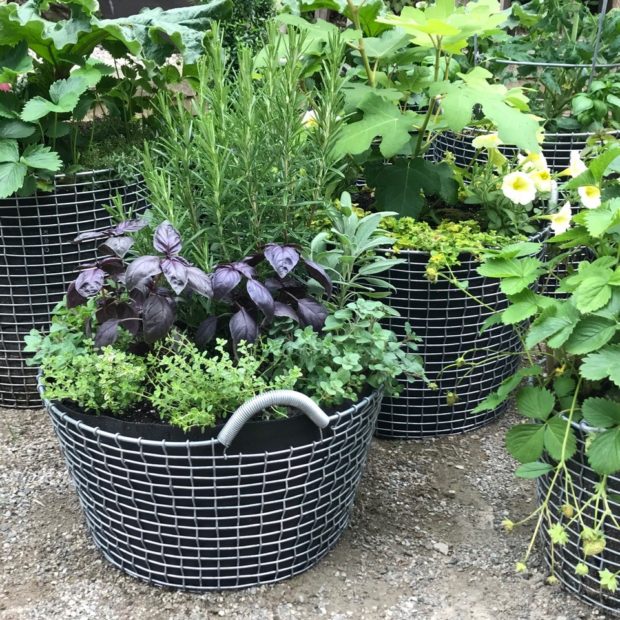 Rob plants containers in May in his own inimitable and sustaining style. He puts up planters that combine herbs, vegetables and flowers in a relaxed and graceful way. His plantings strongly evoke the agricultural roots of all gardening. Planting crops that feed communities is life sustaining. A place for growing vegetables and herbs in the garden takes many forms. Some gardeners plant ornamental plants incidental to a working garden. Others want a few tomatoes and some herbs to cook with. No matter the form or extent, growing those plants that sustain life sustains a very basic emotional need – a working connection to nature of which we are all a part. Rob is apt to purchase lots of containers that compliment these first container plantings. Baskets of all shapes and styles, wood boxes and crates, galvanized buckets and tubs all speak to the farm garden. Even the contemporary stainless steel wire baskets with fabric liners pictured above pair remarkably well with a planting of herbs.
Rob plants containers in May in his own inimitable and sustaining style. He puts up planters that combine herbs, vegetables and flowers in a relaxed and graceful way. His plantings strongly evoke the agricultural roots of all gardening. Planting crops that feed communities is life sustaining. A place for growing vegetables and herbs in the garden takes many forms. Some gardeners plant ornamental plants incidental to a working garden. Others want a few tomatoes and some herbs to cook with. No matter the form or extent, growing those plants that sustain life sustains a very basic emotional need – a working connection to nature of which we are all a part. Rob is apt to purchase lots of containers that compliment these first container plantings. Baskets of all shapes and styles, wood boxes and crates, galvanized buckets and tubs all speak to the farm garden. Even the contemporary stainless steel wire baskets with fabric liners pictured above pair remarkably well with a planting of herbs.
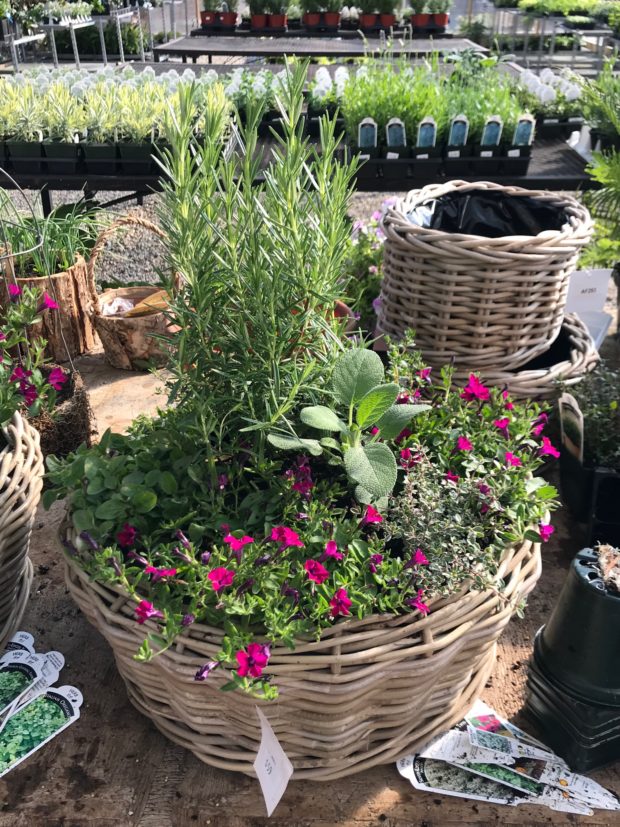 The herb pots come first for a simple reason. They not only whet the appetite for the summer season to come, many herbs – basil excepted – are quite tolerant of unpredictably chilly spring weather. The pot pictured above is planted with a couple miniature petunias. They shrug off cold weather as well. The plastic liner in the reed baskets help improve their longevity.
The herb pots come first for a simple reason. They not only whet the appetite for the summer season to come, many herbs – basil excepted – are quite tolerant of unpredictably chilly spring weather. The pot pictured above is planted with a couple miniature petunias. They shrug off cold weather as well. The plastic liner in the reed baskets help improve their longevity.
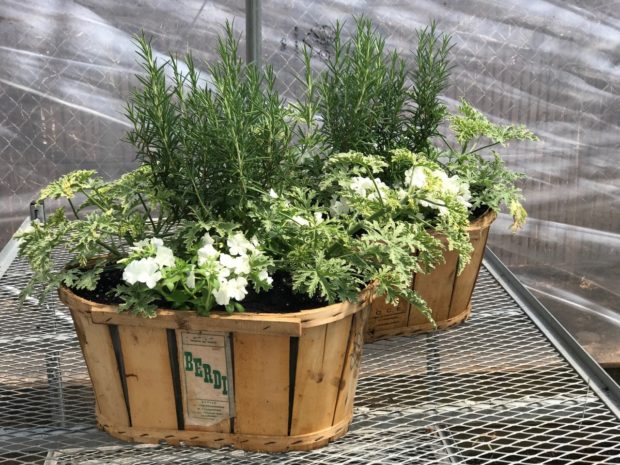 vintage berry baskets planted with rosemary, variegated scented geraniums and anbual phlox
vintage berry baskets planted with rosemary, variegated scented geraniums and anbual phlox
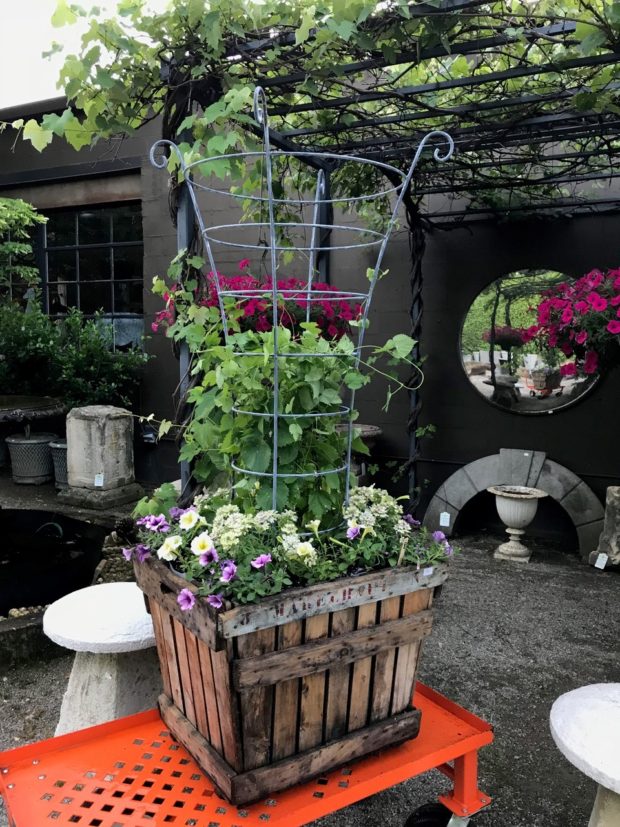 Will the grapes produced by this grapevine be sufficient for a few bottles of home made wine, or jars of marmalade? No. But planted up in a vintage champagne grape crate, this container planting is earthy in every regard.
Will the grapes produced by this grapevine be sufficient for a few bottles of home made wine, or jars of marmalade? No. But planted up in a vintage champagne grape crate, this container planting is earthy in every regard.
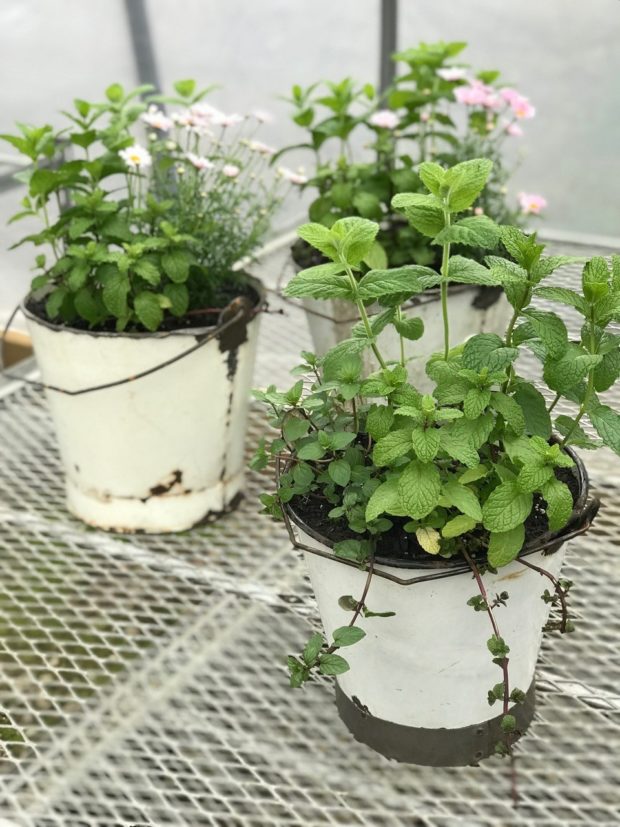 Mint is an impossible thug in the garden. It will run everywhere, and is very difficult to eradicate or control. But a planting in a bucket means this fragrant herb is available for seasoning lamb or as a garnish in a summer drink.
Mint is an impossible thug in the garden. It will run everywhere, and is very difficult to eradicate or control. But a planting in a bucket means this fragrant herb is available for seasoning lamb or as a garnish in a summer drink.
 Topiary plant forms have long been a mainstay of the formal garden. The tin pots Rob chose for them recall that history. These lavender and scented geraniums on standard are a more cottage garden version that pair will with pots of herbs and flowers. These are under planted with alyssum and lavender bacopa.
Topiary plant forms have long been a mainstay of the formal garden. The tin pots Rob chose for them recall that history. These lavender and scented geraniums on standard are a more cottage garden version that pair will with pots of herbs and flowers. These are under planted with alyssum and lavender bacopa.
 vintage oval bucket filled with basil
vintage oval bucket filled with basil
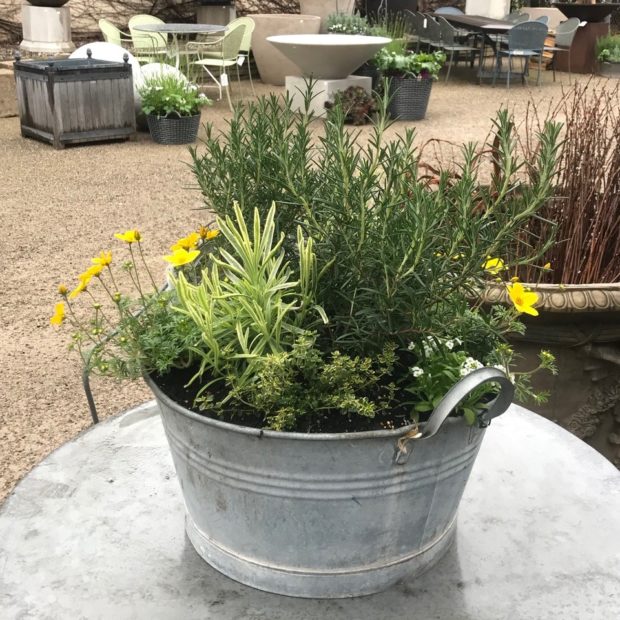 rosemary, variegated lavender, bidens, variegated thyme and alyssum
rosemary, variegated lavender, bidens, variegated thyme and alyssum
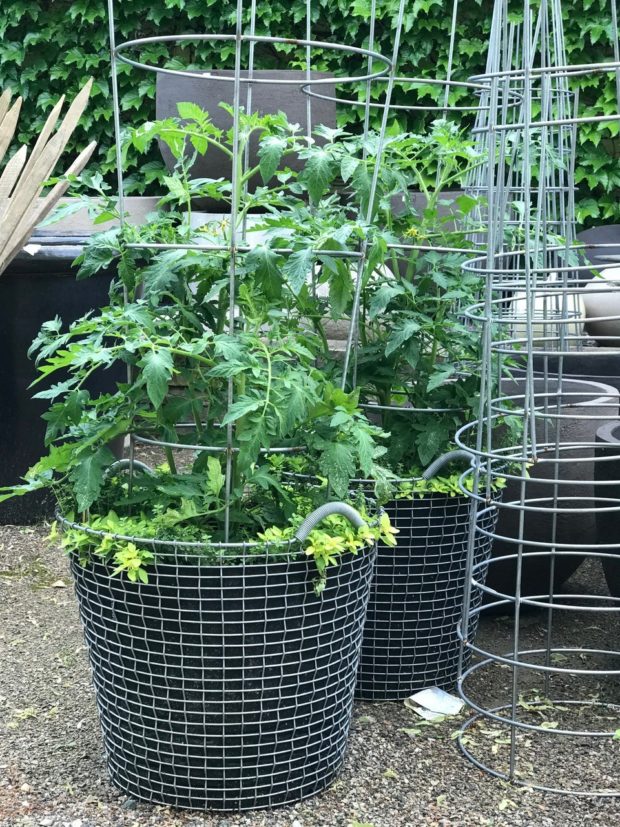 tomato under planted with gold oregano and thyme
tomato under planted with gold oregano and thyme
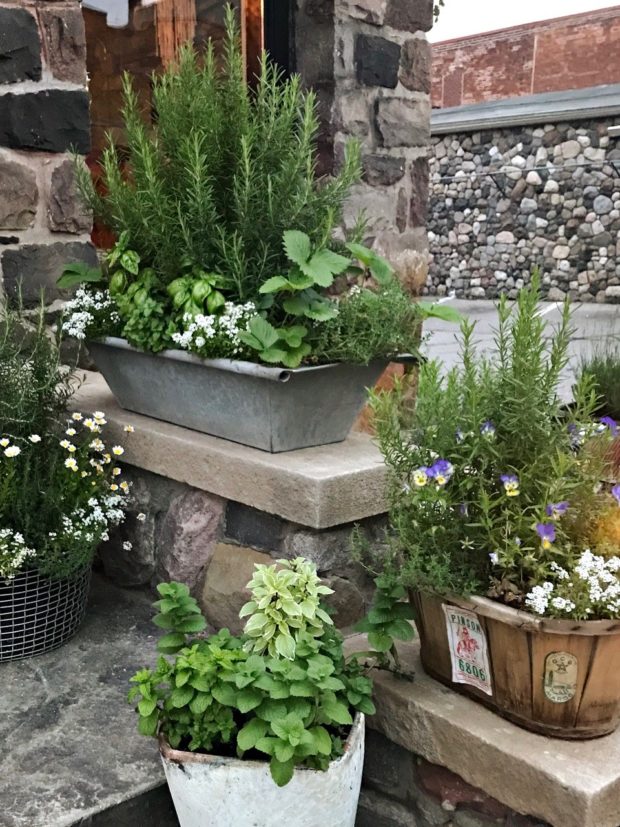 a collection of associated vintage and new pots
a collection of associated vintage and new pots
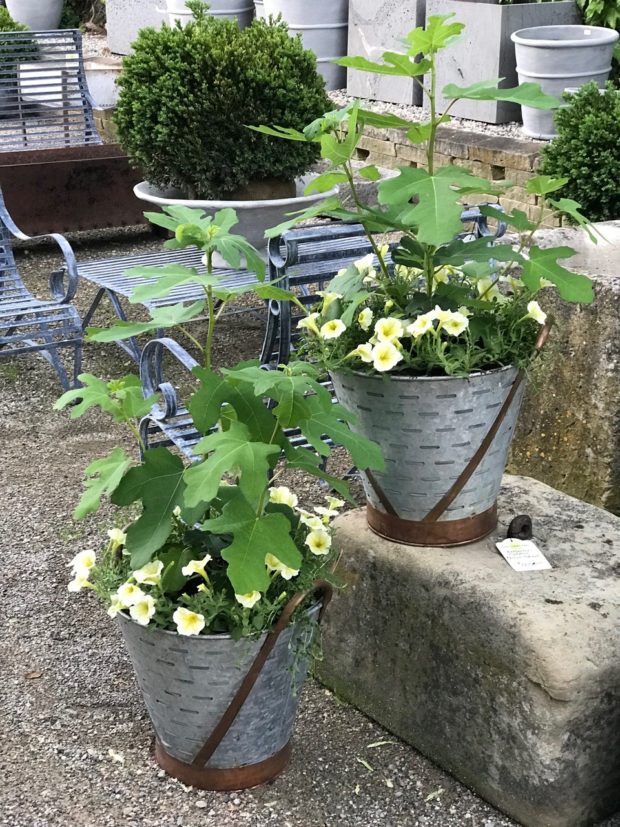 Chicago figs and yellow petunias
Chicago figs and yellow petunias
 tomatoes and herbs planted in terra cotta long toms.
tomatoes and herbs planted in terra cotta long toms.
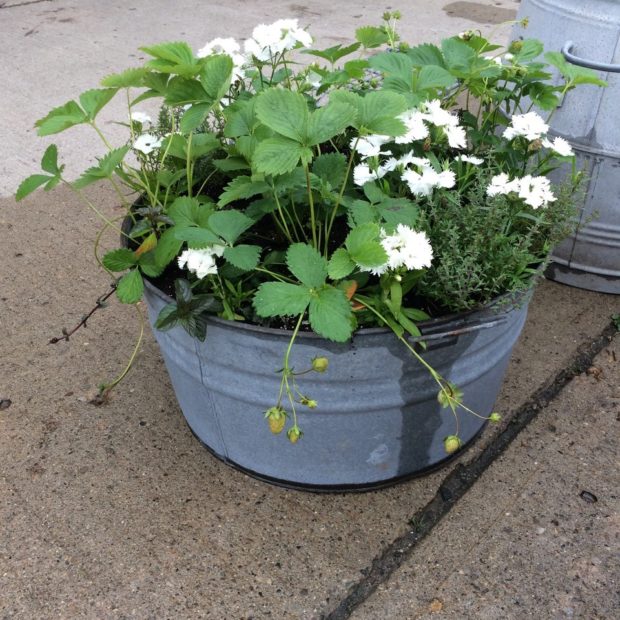 handled bucket with strawberries, thyme, and white dianthus
handled bucket with strawberries, thyme, and white dianthus
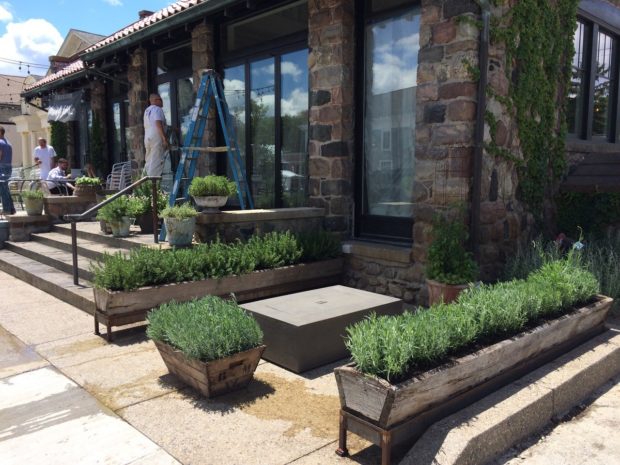 Rob planted The Fed in Clarkston with loads of lavender and herbs last year. He will be doing it again this year. These pots hit all the right notes, don’t they?
Rob planted The Fed in Clarkston with loads of lavender and herbs last year. He will be doing it again this year. These pots hit all the right notes, don’t they?
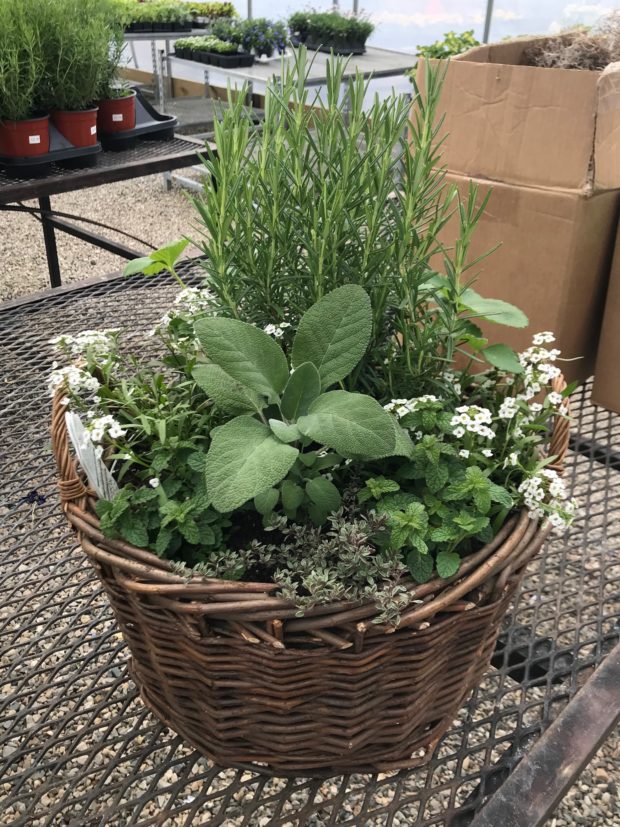
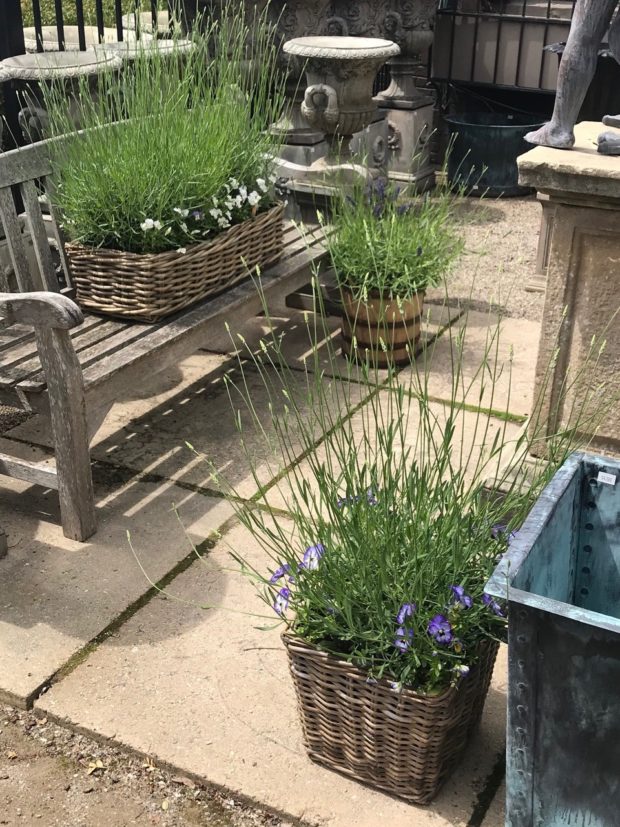
So moving.
Thanks for reading and writing, Michael. all the best, Deborah
Your words so speak to those of us who love growing things – the joy every spring! Growing/gardening just speaks to something deep inside of us.
thanks for the thoughts and the lovely pictures- such an inspiration about mixing things together!
Laurie
Dear Laurie, mixing things up is a god place to start with anything. Thank you for writing. best, Deborah
Thanks for the inspirational message. Much appreciated.
Dear Amy, my thanks to you for reading. best regards, Deborah
Thank you Deborah, this post brought tears to my eyes. During this trying time for the world we need to focus on the basics of life. Love, food, encouraging and helping mankind. Herbs, awaken our senses, and add love to the table.
You are an inspiration. When is your book going to be on the market?
Dear Deborah, Ha! someday there will be time to write a book. In the meantime, I greatly enjoy this connection to other gardeners. thanks, Deborah
Your thoughts and pictures made my afternoon!
Cheers! Mary Ann